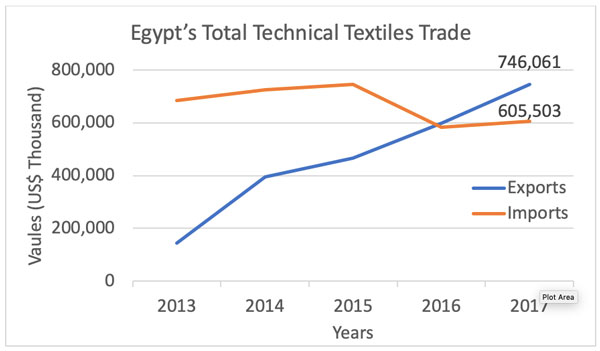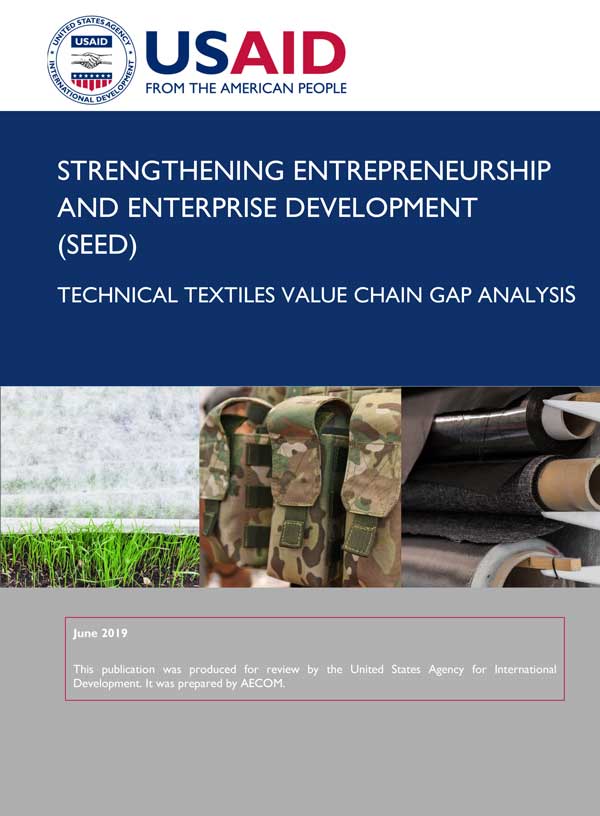Technical Textiles Market in Egypt :: According to a report published by the USAID and prepared by inTEXive consulting, the future of the technical textiles market in Egypt has promising opportunities.
Egypt’s technical textiles sector is emerging with total imports of US$ 605.4 million and total exports of US$ 746 million in 2017.
The exports are growing at a very fast rate CAGR 51% from 2013-2017, while the imports are slightly decreasing. Major imports included polymer laid nonwoven (US$ 96.9 million), coated and laminated fabrics (US$ 93.6 million), Packtech (US$ 71.84 million), and Protech (US$ 43 million). Whereas, major exports included Medtech (US$ 283 million), glass fiber yarns and fabrics (US$ 160.5 million), Sporttech (US$ 147.2 million), and polymer laid nonwoven (US$ 66.6 million).

Major imports partners were Asia Pacific (US$ 300 million), Europe (US$ 150 million) and the Middle East (US$ 102 million), while major exports partners were Europe (US$ 273 million), Africa (US$ 188 million) and the Middle East (US$ 170 million).
This market analysis is part of a project funded by USAID’s SEED in partnership with the Egyptian Ministry for Trade and Industry and implemented by inTEXive Consulting. The project report “Technical Textile Value Chain Gap Analysis in Egypt” is the first and only report that provides a comprehensive analysis of the technical textiles value chain in Egypt, it acts as a guide for strategic planning and future investments.
The report is considered a valuable resource for government agencies, international organizations, financial institutions, private companies, and investors. The report features a comprehensive list of major Egyptian producers of technical textiles classified based on their value chain level. The report also includes 58 market data tables and 58 figures spread through 126 pages of in-depth analysis of the technical textiles value chain in Egypt. Moreover, the report features the first published dictionary of HS codes classifying the technical textiles based on raw material and end-products, including 192 codes at the 6-digit level.
The report provides a detailed mapping of the technical textiles value chain in Egypt in addition to an in-depth trade analysis. In the trade analysis, the data was categorized and classified according to the International Harmonized System of codes. Imports and exports data for these commodity codes were analyzed for a five years period starting 2013 and ending in 2017 and the compounded annual growth rates was calculated.

The report also includes an in-depth SWOT analysis of the technical textiles value chain in Egypt, a total of 27 interviews were conducted to better understand the strengths, weaknesses, opportunities and threats pertaining to the technical textiles value chain in Egypt. Interviews were conducted with different producers of raw materials, end products, auxiliaries’ producers, and service providers such as machine makers, testing and research institutes, development associations, and governmental entities. Afterwards, the report presented the bottlenecks and constraints facing the technical textile industry in Egypt, major bottlenecks included, lack of technical expertise, difficulty in sourcing high performance raw materials, and required large capital investment. The report provided suggested interventions along with suggested entities and association who are responsible for those interventions. In addition to, showcasing a successful model for growing the technical textiles industry in India.
The report is available as an open access to support the growth of this industry and to enable decision makers to make confident business decisions in this highly competitive industry.



















